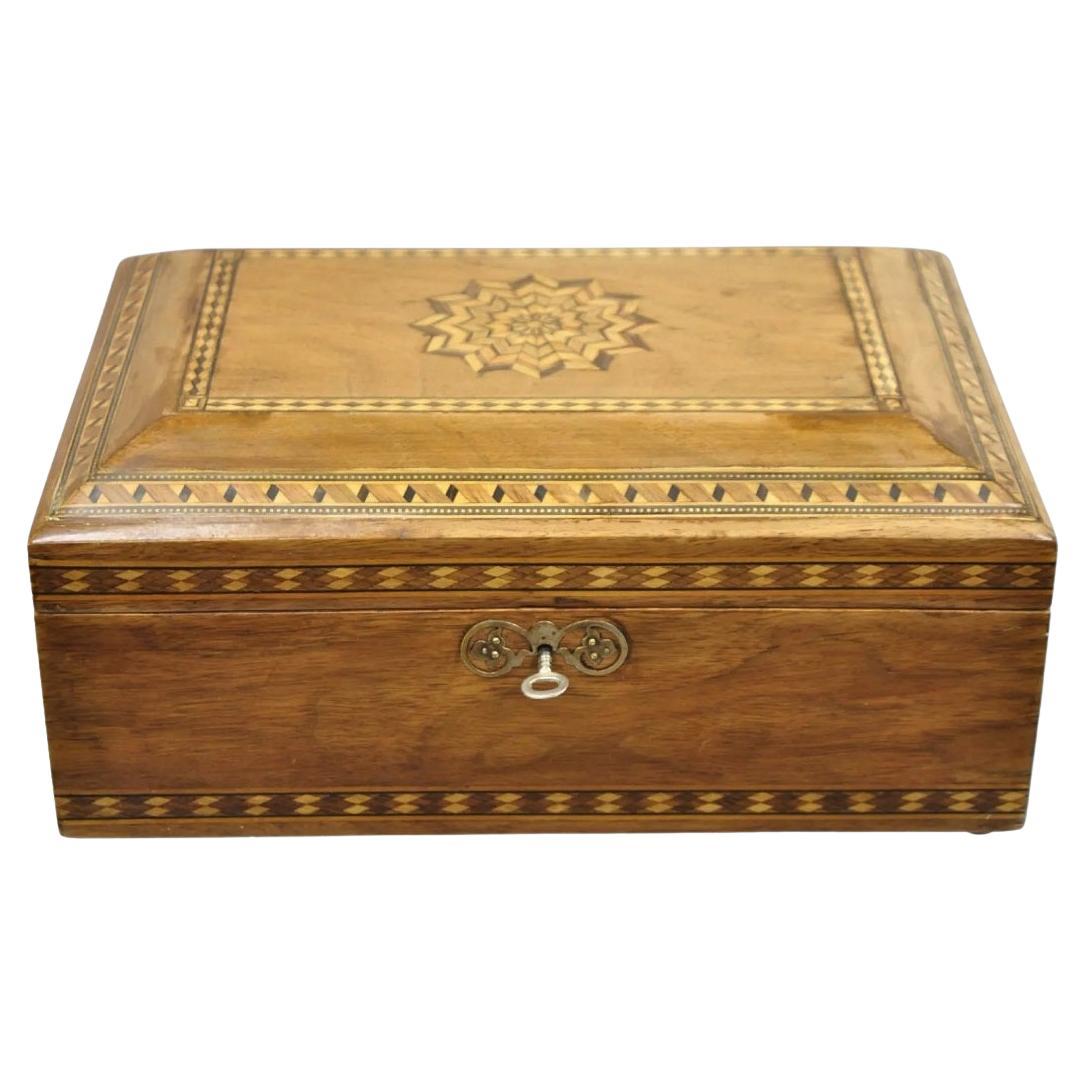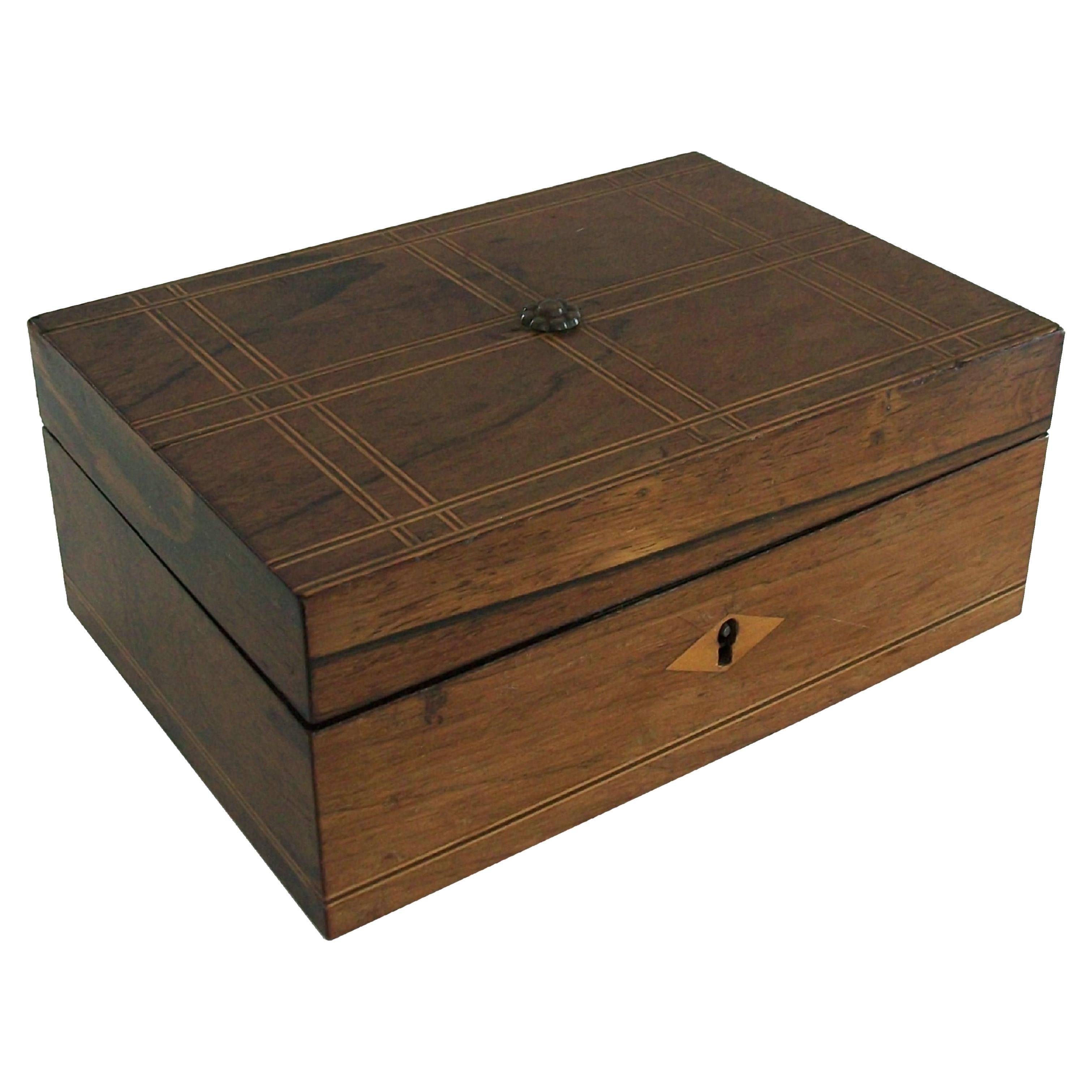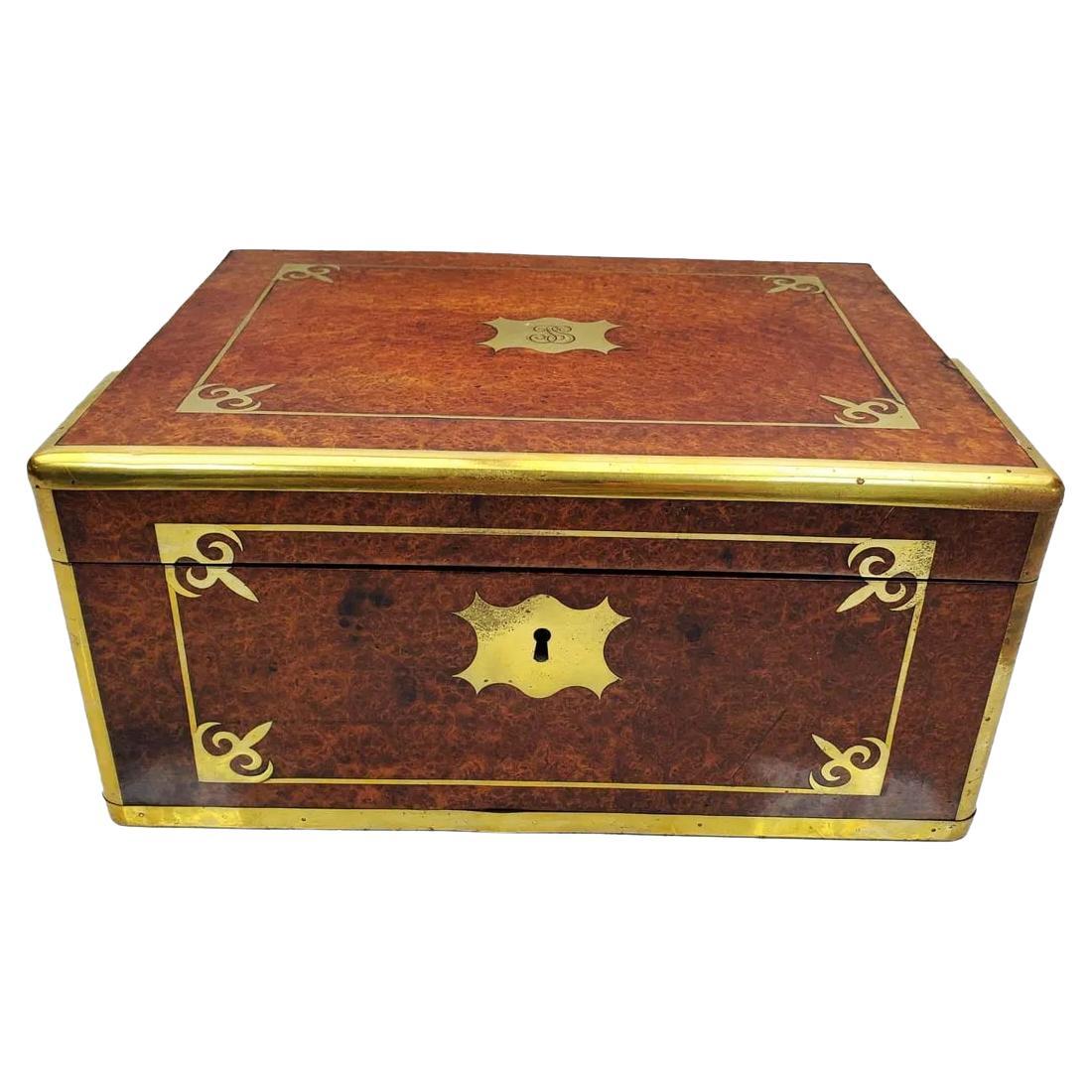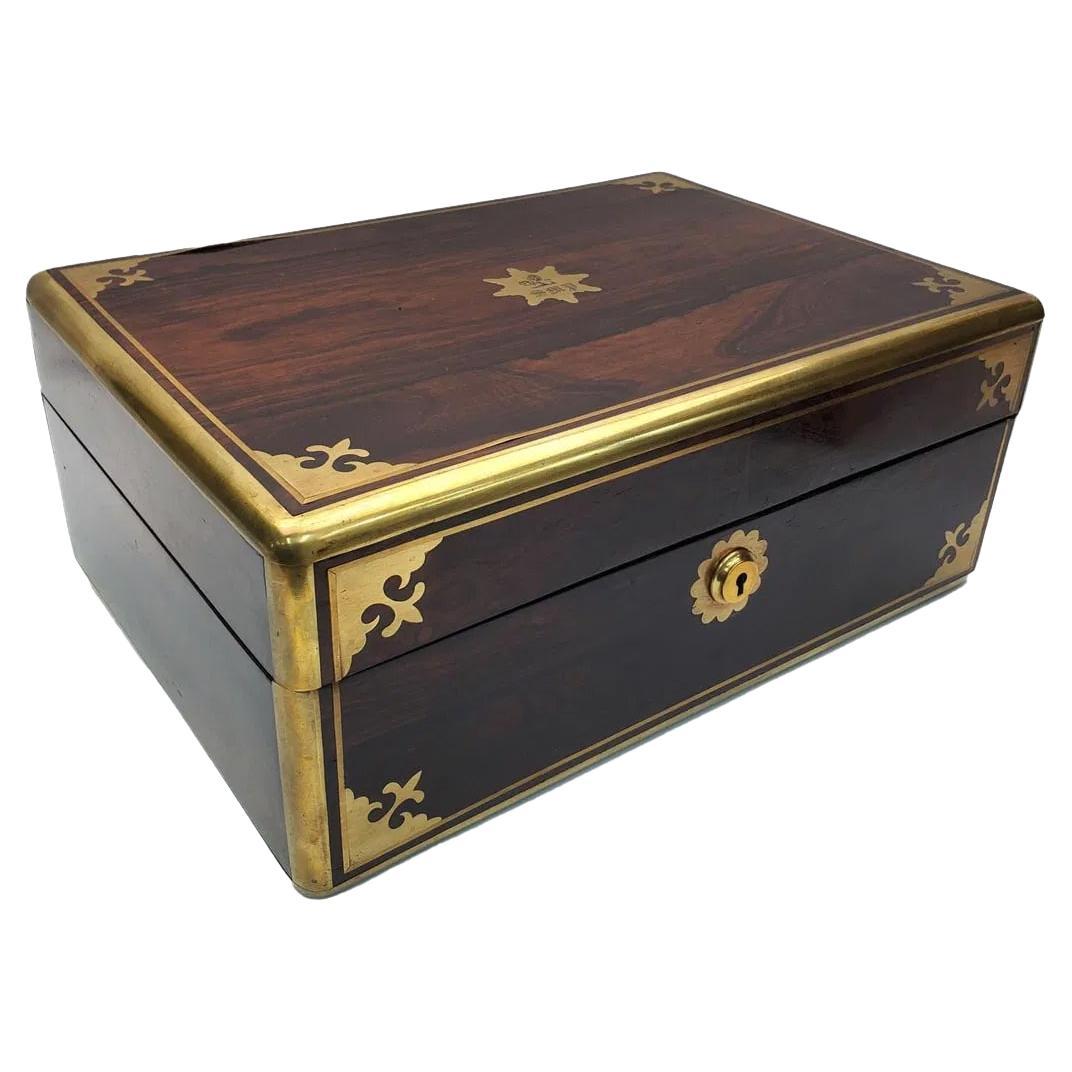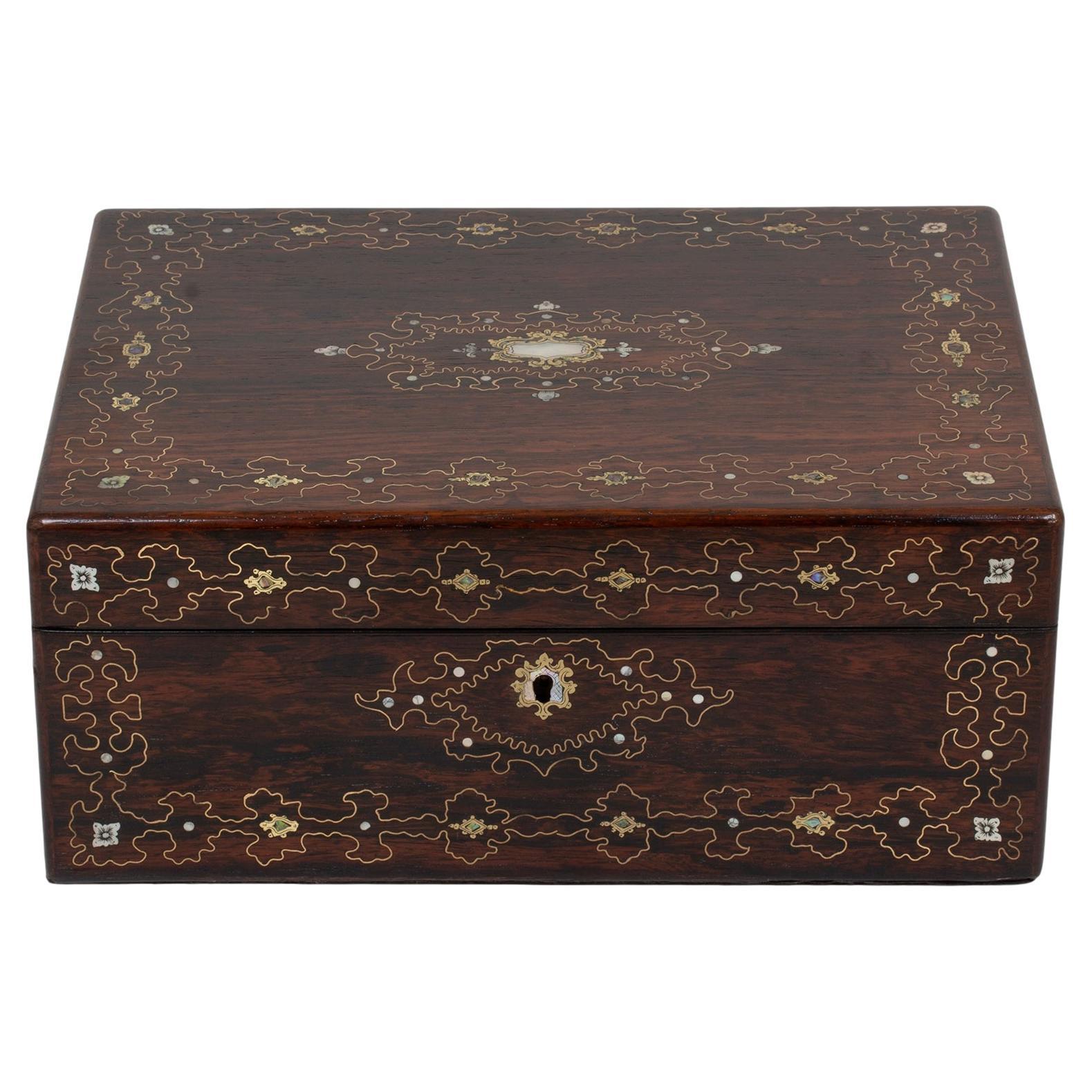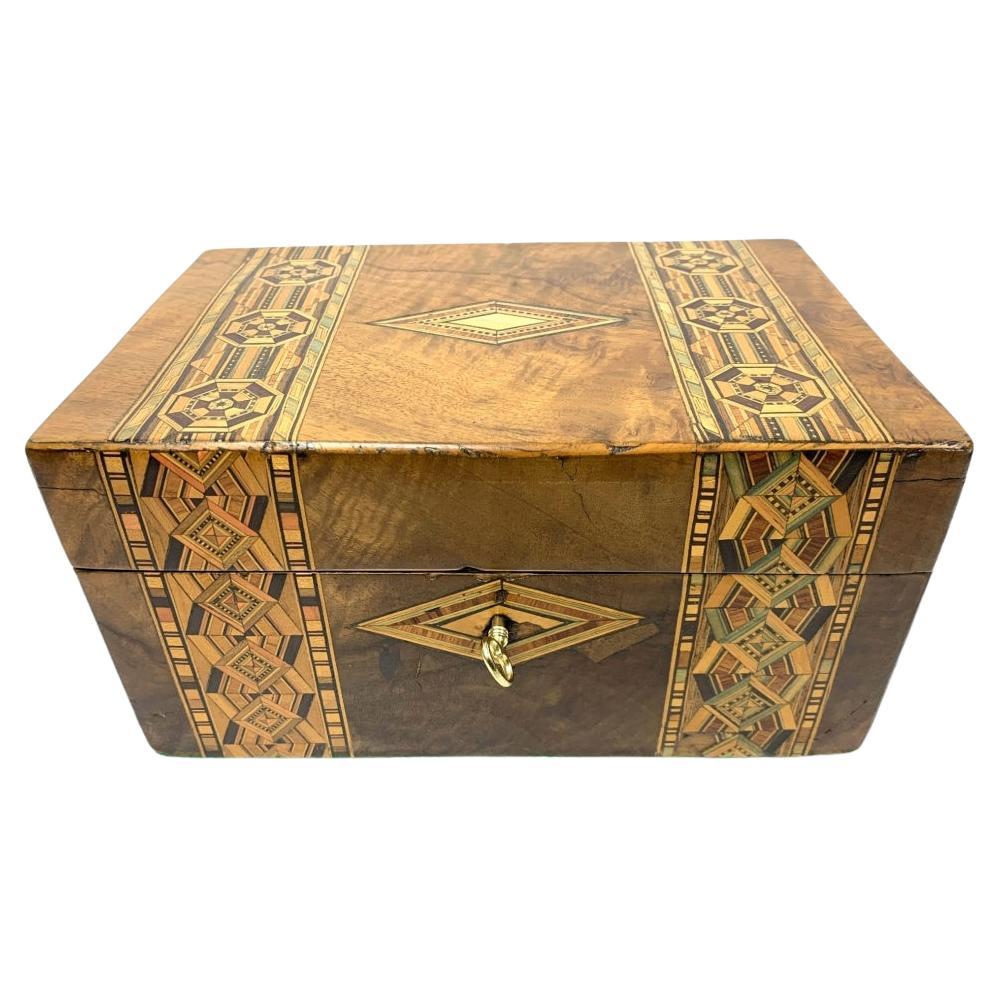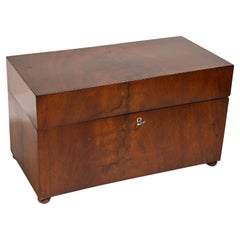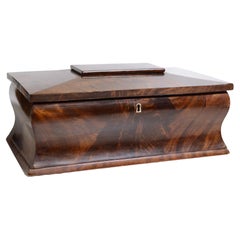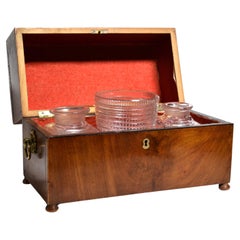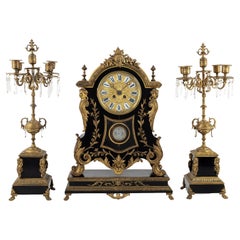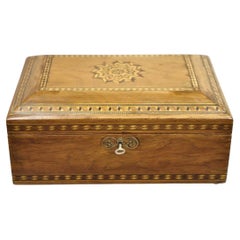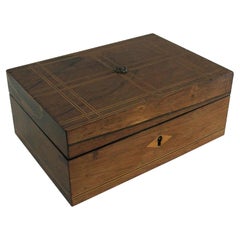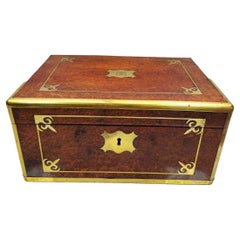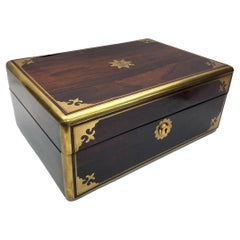Items Similar to British Antique Brass Marquetry Toilette Box with History and Many Drawers
Want more images or videos?
Request additional images or videos from the seller
1 of 12
British Antique Brass Marquetry Toilette Box with History and Many Drawers
$1,300
£980.54
€1,132.53
CA$1,821.39
A$2,025.28
CHF 1,060.27
MX$24,739.18
NOK 13,323.35
SEK 12,533.28
DKK 8,454.25
About the Item
According to motto "Perseverantia et Amicis" (Perseverance and Friends) with Bird (dove) holding olive-branch, this amazing, luxurious "necessaire" comes from family ofacknowledged London's Book Publisher John Fowler Dove (1787-1866) of St John's Square in Clerkenwell.
Being of impressive size: 37 x 28,5 x 19 cm (roughly 14,56 x 11,2 x 7,5 in) this magnificent casket incorporatesall possible features of its time reaching "state of the art" level for its time fashion boutiques. In general good condition, needs re-upholstery of internal compartments, if you pay attention to the appearance of the box, the exterior was recently restored (veneer, brass, etc.). I am not familiar with ladies tricks so please study pictures of interior and side drawer to find out what was the purpose of each compartment. I can see it is missing some boxes or some accessories, but hope that new owner agrees to adore exterior of this beautiful box first of all. Please study good resolution images for overall cosmetic condition. In person actual item may appear darker or brighter than in our pictures, strictly depending on sufficient light in your environment. Weight of app. 6,4 kg it is going to measure 8 kg packed for shipment (for my record).
As for the initial owners: John Fowler Dove was born 20th October 1787 and baptized on the 18th November of that year at the local church of St. Gregory at Sudbury, in Suffolk the son of Humphry Dove and his wife Ruth Yardley. He was apprenticed in to the Stationers Company in 1803 and was active as a printer in Clerkenwellin his own right from at least as early as 1813, probably earlier. There he remained for the next twenty years, although he briefly had additional premises on Piccadilly either side of 1830. He worked extensively for John Murray and other publishers and is known especially for the classical texts he printed for Richard Priestley. That he was in quite a large way of business is attested in the reports of trial in 1826 of one of his former employees for stealing 130 lbs of type from the Clerkenwell premises, probably with the help of accomplices. It says much for his humanity that on hearing that the culprit's wife had no money for food he went around in person to give her financial assistance. In or about 1833, while still in his forties, he retired to Suffolk with his wife, Elizabeth Dove / Debenham (Born in Depden on 22 Nov 1787 to Robert Debenham and Elizabeth Bigsby. passed away on 12 Jul 1876 in Horringer, Suffolk, England), whom he had married in 1812. Whether it was a matter of family money or that he had made a handsome fortune from the "English Classics", he plainly had no need to work again. Hisonly further appearance in public life appears to have been the occasion on which he held an oak sapling for Queen Victoria to plant at Burghley in 1844 (Prince Albert planted a lime). Dove was apparently staying at Burghley at the time. The Queen was charmed and asked for his address so that she could write to him. For the remainder of his life, he lived at a house or cottage called Hopleys at Horningsheath, with his wife, a cook, and a house maid. On the1851 census return he was recorded as having "no profession, but occupier of a park of fifty acres". He died on the 17th October 1866 and there is a memorial to him in St. Leonard's churchyard at Horringer. After his retirement from the book trade, "Dove's English Classics" were taken over by his successors, "Scott & Webster" ("Scott, Webster & Geary" from 1836) and some further titles were added.
- Dimensions:Height: 7.5 in (19.05 cm)Width: 14.56 in (36.99 cm)Depth: 11.2 in (28.45 cm)
- Style:Victorian (Of the Period)
- Materials and Techniques:
- Place of Origin:
- Period:
- Date of Manufacture:e.g. 1810-1860
- Condition:Repaired: if you pay attention to the appearance of the box, the exterior was recently restored (veneer, brass, etc.). Reupholstered. Wear consistent with age and use. Minor losses. Minor structural damages. Minor fading. In general good condition, needs re-upholstery of internal compartments, if you pay attention to the appearance of the box, the exterior was recently restored (veneer, brass, etc.).
- Seller Location:Sweden, SE
- Reference Number:1stDibs: LU8776239700592
About the Seller
No Reviews Yet
Vetted Professional Seller
Every seller passes strict standards for authenticity and reliability
1stDibs seller since 2023
13 sales on 1stDibs
Typical response time: 1 hour
- ShippingRetrieving quote...Shipping from: Sweden, Sweden
- Return Policy
Authenticity Guarantee
In the unlikely event there’s an issue with an item’s authenticity, contact us within 1 year for a full refund. DetailsMoney-Back Guarantee
If your item is not as described, is damaged in transit, or does not arrive, contact us within 7 days for a full refund. Details24-Hour Cancellation
You have a 24-hour grace period in which to reconsider your purchase, with no questions asked.Vetted Professional Sellers
Our world-class sellers must adhere to strict standards for service and quality, maintaining the integrity of our listings.Price-Match Guarantee
If you find that a seller listed the same item for a lower price elsewhere, we’ll match it.Trusted Global Delivery
Our best-in-class carrier network provides specialized shipping options worldwide, including custom delivery.More From This Seller
View AllAntique Flame Mahogany Empire Tea Caddy Wooden Casket Box 19th century
Located in Sweden, SE
Rectangular shape mahogany veneered casket made in first half of 19th century presumably in Europe. High quality work of applied arts in Neoclassical (Biedermeier) style. The fork of...
Category
Antique Late 19th Century Empire Tea Caddies
Materials
Wood, Mahogany
Wooden Casket Box with Mirror mid 19th century Flame Mahogany Biedermeier
Located in Sweden, SE
This exquisite flame mahogany veneered casket, originating from Central Europe mid 19th century, is a stunning example of Neoclassical applied arts. Its original shape and high quali...
Category
Antique Early 19th Century European Neoclassical Decorative Boxes
Materials
Mahogany
Mahogany Tea Caddy Wooden Casket Box w Antique Glass Empire early 19th century
Located in Sweden, SE
Rectangular shape mahogany veneered casket made in first half of 19th century presumably in Europe. Cast glass vessels are intact at their original place. Candy sugar bowl along with...
Category
Antique Mid-19th Century Empire Decorative Boxes
Materials
Glass, Cut Glass, Mahogany
Louis XV Antique Boulle Clock Set Black Wood and Gild Bronze 19th century
By Japy Frères
Located in Sweden, SE
Amazing historicism clock ensemble in the style of Louis XV (late Baroque) with gorgeous architecture. This is a fine example of custom bronze work that is available on the antique market. Made in the second half of the 19th century, clock movement by Frédéric Japy (marked on cased), hand chased and gilt bronze décor of quality. Complete with 2 five-light candelabra, pendulum and key the clock itself stands on the included wooden base. Running and strikes on spring. Antique wooden clocks...
Category
Antique Late 19th Century Baroque Table Clocks and Desk Clocks
Materials
Brass, Bronze
Antique French Japy Freres Gilt Bronze Rococo Clock 19th century
By Japy Frères
Located in Sweden, SE
Very good condition, repairs to dial, minor age and usage wear, gold finish well preserved, movement is running only with pendulum off and not striking at all as needs service.
Category
Antique Late 19th Century French Rococo Table Clocks and Desk Clocks
Materials
Brass, Bronze
Antique Wooden Ericsson MB 115 Crank Magneto Field Telephone 1895 С Mark 1
By L.M. Ericsson
Located in Sweden, SE
Rare, hard to find. Telephone “C” Mark 1 (Mk 1), designed by Ericsson’s of Stockholm, was the first portable military telephone. It was used in large numbers in the South African War of 1899-1902 by the Telegraph Battalion RE and became the standard field telephone...
Category
Antique Late 19th Century Swedish Art Nouveau Desks
Materials
Metal, Brass
You May Also Like
Antique English Marquetry Inlaid Wood Large Tea Caddy Lined in Metal Desk Box
Located in Philadelphia, PA
Antique English Marquetry Inlaid Wood Large Tea Caddy / Desk Box Lined in Metal with Working Lock and Key. Circa Late 19th Century. Measurements: 5.5" H x 12" W x 8.25" D.
Category
Antique Late 19th Century Unknown Other Tea Caddies
Materials
Wood
Antique Victorian Marquetry Jewelry Box w/ Satinwood & Ebony - U.K. - Circa 1880
Located in Chatham, ON
Antique Victorian marquetry jewelry box with satinwood and ebony stringing - fine quality with aged patina - featuring veneered top and sides - diamond shaped satinwood key escutcheo...
Category
Antique Late 19th Century English Victorian Jewelry Boxes
Materials
Wood, Ebony, Satinwood, Paper
$595 Sale Price
20% Off
Regency Brass Inlaid and Bound Thuya Wood Jewlery or Dresser Box
Located in Chapel Hill, NC
Late Georgian / Early Victorian dresser box in thuya wood burl with quarter round brass edges, the top and front inlaid with brass lines connecting decorative corner devices centerin...
Category
Antique Mid-19th Century English Early Victorian Jewelry Boxes
Materials
Brass
19th Century Brass Bound and Inlaid Rosewood Jewelry Box
Located in Chapel Hill, NC
Mid 19th century English rosewood box with rounded brass edges, the top and front inlaid with brass lines and decorative devices in the corners. T...
Category
Antique Mid-19th Century English Early Victorian Decorative Boxes
Materials
Brass
Antique English Rosewood Inlaid Jewellery Box
Located in Northampton, GB
Fully Partitioned Jewellery Tray
From our Jewellery Boxes collection, we are delighted to offer this Rosewood Inlaid Jewellery Box. The Jewellery Box of slim rectangular form venee...
Category
Antique Early 19th Century English Early Victorian Jewelry Boxes
Materials
Shell, Wood
Antique English Large Tunbridge Box With Marquetry Inlay
By Tunbridge Ware
Located in Bridgeport, CT
An antique English Tunbridge box with geometric inlay, hinged lid, red velvet interior, felted bottom and comes with working key. The box with a diamond form inlaid medallion flanked...
Category
Antique 19th Century English Victorian Decorative Boxes
Materials
Velvet, Wood
More Ways To Browse
British Antiques
Call Box
Money Box
Antique Light Box
Wood Box With Drawers
G Albert
Antique Money Box
Antique Brass Level
Midcentury Brass Plants
Antique Olive Wood
Used Victoria Birds
17th Century Marquetry
Church Box
Limed Oak Bedroom Furniture
17th Century Upholstery
Adore Dior
Antique Brass Money Boxes
Leonards Antiques
